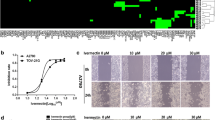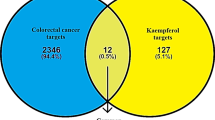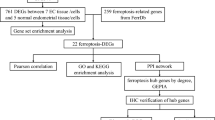Abstract
Current studies have demonstrated that significant increased LPA levels to be observed in ascites in patients with ovarian cancer. Although several studies have shown that Lysophosphatidic acid (LPA) related to the progression of ovarian cancer, which LPA receptors (LPARs) and G-coupled protein subtypes mediated in LPA actions have not been clearly elucidated. This study aimed to clarify the roles of LPA and it is subtype-specific LPARs mediating mechanisms in ovarian cancer integrated using bioinformatic analysis and biological experimental approaches. The big data analysis shown that LPA3 was the only differentially expressed LPA receptor among the six LPARs in ovarian cancer and further verified in immunohistochemistry of tissue microarrays. Also found that LPA3 was also highly expressed in ovarian cancer tissue and ovarian cancer cells. Importantly, LPA significantly promoted the proliferation and migration of LPA3-overexpressing ovarian cancer cells, while the LPA-induced actions blocked by Ki16425, a LPAR1/3 antagonist treated, and LPA3-shRNA transfected. In vivo study indicated that the LPA3-overexpressing cell-derived tumors metastasis, tumors volume, and tumors mass were apparently increased in xenografted nude mice. In addition, we also observed that LPA3 was differential high expression in ovarian cancer tissue of the patients. Our studies further confirmed the LPA3/Gi/MAPKs/NF-κB signals were involved in LPA-induced oncogenic actions in ovarian cancer cells. Our findings indicated that the LPA3 might be a novel precise therapeutic target and potential biomarker for ovarian cancer.




Similar content being viewed by others
Data availability
All data included in this study are available upon request by contact with the corresponding author.
Code availability
Not applicable.
References
Xu Y. Targeting lysophosphatidic acid in cancer: the issues in moving from bench to bedside. Cancers. 2019;11:1523.
Tang X, Brindley DN. Lipid phosphate phosphatases and cancer. Biomolecules. 2020;10:1263.
Ha JH, Radhakrishnan R, Jayaraman M, et al. LPA induces metabolic reprogramming in ovarian cancer via a pseudohypoxic response. Cancer Res. 2018;78:1923–34.
Wu D, Wu F, Li B, et al. EZH2 promotes the expression of LPA1 by mediating microRNA-139 promoter methylation to accelerate the development of ovarian cancer. Cancer Cell Int. 2020;20:551.
Zhao PF, Wu S, Li Y, et al. LPA receptor1 antagonists as anticancer agents suppress human lung tumours. Eur J Pharmacol. 2020;868:172886.
Shi W, Zhang C, Ning Z, et al. CMTM8 as an LPA1-associated partner mediates lysophosphatidic acid-induced pancreatic cancer metastasis. Ann Transl Med. 2021;9:42.
Ueda N, Minami K, Ishimoto K, et al. Effects of lysophosphatidic acid (LPA) receptor-2 (LPA2) and LPA3 on the regulation of chemoresistance to anticancer drug in lung cancer cells. Cell Signal. 2020;69:109551.
Minami K, Ueda N, Ishimoto K, et al. Cooperation of G12/13 and Gi proteins via lysophosphatidic acid receptor-2 (LPA2) signaling enhances cancer cell survival to cisplatin. Biochem Biophys Res Commun. 2020;532:427–32.
Xu Y, Shen Z, Wiper DW, et al. Lysophosphatidic acid as a potential biomarker for ovarian and other gynecologic cancers. JAMA. 1998;280:719–23.
Bai CQ, Yao YW, Liu CH, et al. Diagnostic and prognostic significance of lysophosphatidic acid in malignant pleural effusions. J Thorac Dis. 2014;6:483–90.
Zeng R, Li B, Huang J, et al. Lysophosphatidic acid is a biomarker for peritoneal carcinomatosis of gastric cancer and correlates with poor prognosis. Genet Test Molr Biomark. 2017;21:641–8.
Siegel RL, Miller KD, Jemal A. Cancer statistics, 2020. CA. 2020;70:7–30.
Ray U, Chowdhury SR, Vasudevan M, et al. Gene regulatory networking reveals the molecular cue to lysophosphatidic acid-induced metabolic adaptations in ovarian cancer cells. Mol Oncol. 2017;11:491.
Park J, Jang JH, Oh S, et al. LPA-induced migration of ovarian cancer cells requires activation of ERM proteins via LPA1 and LPA2. Cell Signal. 2018;44:138.
Li GC, Qin XL, Song HH, et al. Upregulated microRNA-15b alleviates ovarian cancer through inhitbition of the PI3K/Akt pathway by targeting LPAR3. J Cell Physiol. 2019;234:22331–42.
Azim HA Jr, Peccatori FA, Brohee S, et al. RANK-ligand (RANKL) expression in young breast cancer patients and during pregnancy. Breast Cancer Res. 2015;17:24.
Ediriweera MK, Tennekoon KH, Samarakoon SR. Role of the PI3K/AKT/mTOR signaling pathway in ovarian cancer: biological and therapeutic significance. Semin Cancer Biol. 2019;59:147–60.
Kan Y, Liu J, Li F. High expression of nuclear transcription factor-kappaB is associated with cisplatin resistance and prognosis for ovarian cancer. Cancer Manage Res. 2020;12:8241–52.
Kyo S, Ishikawa N, Nakamura K, et al. The fallopian tube as origin of ovarian cancer: change of diagnostic and preventive strategies. Cancer Med. 2020;9:421–31.
Onallah H, Davidson B, Reich R. Diverse effects of lysophosphatidic acid receptors on ovarian cancer signaling pathways. J Oncol. 2019;2019:7547469.
Soleimani A, Rahmani F, Ferns GA, et al. Role of the NF-κB signaling pathway in the pathogenesis of colorectal cancer. Gene. 2019;726:144132.
Wang L, Niu Z, Wang X, et al. PHD2 exerts anti-cancer and anti-inflammatory effects in colon cancer xenografts mice via attenuating NF-κB activity. Life Sci. 2019;242:117167.
Chi HC, Tsai CY, Tsai MM, et al. Roles of long noncoding RNAs in recurrence and metastasis of radiotherapy-resistant cancer stem cells. Int J Mol Sci. 2017;18:1903.
Wu D, Yang X, Peng H, et al. OCIAD2 suppressed tumor growth and invasion via AKT pathway in hepatocelluar carcinoma. Carcinogenesis. 2017;38:910–9.
Acknowledgements
We are grateful to Prof. Fumikazu Okajima at Gunma University for a generous gift of the Ki16425.
Funding
This work was supported by the National Natural Science Foundation of China (No. 31860253, 31971219).
Author information
Authors and Affiliations
Contributions
AD and PZ contributed to design the study. PZ, QY, AL, RL, and YY performed the experiment and collected data. YW performed the animal experiments. PZ and HS analyzed the data and wrote the manuscript. AD revised manuscript critically for important intellectual content and final approval of the version submitted for publication. All the authors approved the final manuscript.
Corresponding authors
Ethics declarations
Conflict of interest
The authors report no conflict of interest for this work.
Ethical approval
All experiments used in this study were performed with ethical standards that the Declaration of Helsinki and national and international guidelines. This investigation was reviewed and approved by the Institutional Animal Care and Use Committee of Inner Mongolia University (Approval Number 2020001).
Consent to participate
Not applicable.
Consent for publication
Not applicable.
Additional information
Publisher's Note
Springer Nature remains neutral with regard to jurisdictional claims in published maps and institutional affiliations.
Supplementary Information
Below is the link to the electronic supplementary material.
Rights and permissions
About this article
Cite this article
Zhao, P., Yun, Q., Li, A. et al. LPA3 is a precise therapeutic target and potential biomarker for ovarian cancer. Med Oncol 39, 17 (2022). https://doi.org/10.1007/s12032-021-01616-5
Received:
Accepted:
Published:
DOI: https://doi.org/10.1007/s12032-021-01616-5




